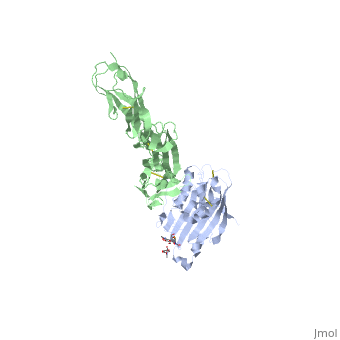4myw
From Proteopedia
Structure of HSV-2 gD bound to nectin-1
Structural highlights
FunctionGD_HHV23 Envelope glycoprotein that binds to the potential host cell entry receptors TNFRSF14/HVEM, PVRL1 and PVRL1. May trigger fusion with host membrane, by recruiting the fusion machinery composed of gB and gH/gL (By similarity). Publication Abstract from PubMedHerpes simplex virus type 1 (HSV-1) and type 2 (HSV-2) are among the most prevalent human pathogens. Both viruses can recognize, via the surface envelope glycoprotein D (gD), human nectin-1 as a functional receptor. Previous studies have successfully elucidated the molecular basis of the binding between HSV-1 gD and nectin-1 by co-crystallography. Despite a high sequence identity between HSV-1 and -2 gDs, the atomic inter-molecule details for HSV-2-gD/nectin-1 interaction remain elusive. Here, we reported the crystal structures of both the unbound and the nectin-1-bound HSV-2 gD. The free gD structure expectedly comprises an IgV-like core and the surface-exposed terminal extensions as observed in its HSV-1 counterpart, but lacks traceable electron densities for a large portion of the terminal elements. These terminal residues were clearly traced in the complex structure as a definitive loop in the N-terminus and an alpha-helix in the C-terminus, thereby showing a conserved nectin-1-binding mode as reported for HSV-1 gD. The interface residues in nectin-1 were further mutated and tested for the gD-interaction by surface plasmon resonance. The resultant binding patterns were similar between HSV-1 and -2 gDs, further supporting a homologous receptor-binding basis by the two viruses for nectin-1. These data, together with a cell-based fusion assay showing a cross-inhibition of the gD/nectin-1 mediated cell-cell fusion by soluble HSV-1 and -2 gDs, provided solid structural and functional evidence that HSV-1/-2 recognizes nectin-1 via the same binding mode. Finally, we also demonstrated that nectin-1 I80 is an important residue involved in gD interaction. IMPORTANCE: Despite intensified studies, a detailed picture of the molecular features in the HSV-2-gD/nectin-1 interaction remains unavailable. Previous work focused on HSV-1 gD, which folds into an IgV-like core with large terminal extensions and utilizes the extension elements to engage nectin-1. Here, we reported the crystal structures of HSV-2 gD in both the free and the nectin-1-bound forms. The atomic inter-molecule details for HSV-2-gD/nectin-1 interaction were clearly presented. The observed binding mode is identical to that reported for its HSV-1 counterpart. This structural observation was further supported by our comparative functional assays showing that nectin-1 mutations similarly affect the ligand/receptor interaction of both virus gDs. Taken together, we provided comprehensive structural and functional data demonstrating a conserved receptor-binding mode between HSV-1 and -2 for nectin-1. Our results also indicate that the tropism-difference between the two viruses likely arises from other aspects rather than the gD/nectin-1 binding-features. Crystal structure of HSV-2 gD bound to nectin-1 reveals a conserved mode of receptor recognition.,Lu G, Zhang N, Qi J, Li Y, Chen Z, Zheng C, Gao GF, Yan J J Virol. 2014 Sep 17. pii: JVI.01906-14. PMID:25231300[1] From MEDLINE®/PubMed®, a database of the U.S. National Library of Medicine. See AlsoReferences
| ||||||||||||||||||||
Categories: Homo sapiens | Human herpesvirus 2 strain 333 | Large Structures | Chen Z | Gao GF | Li Y | Lu G | Qi J | Yan J | Zhang N | Zheng C

